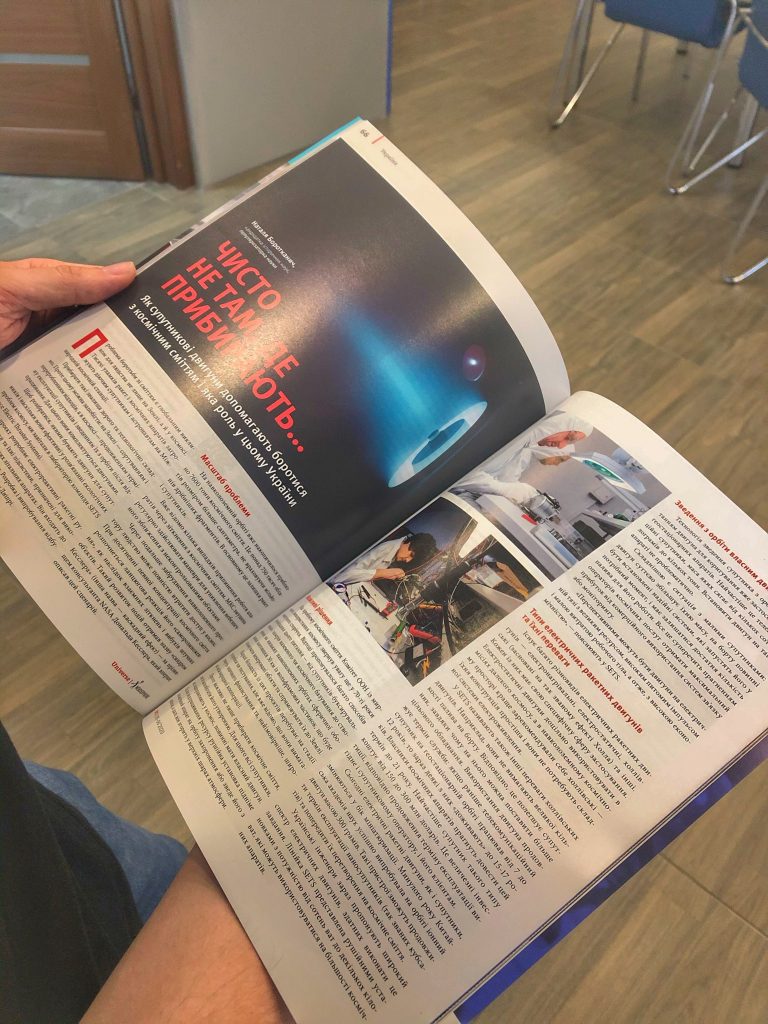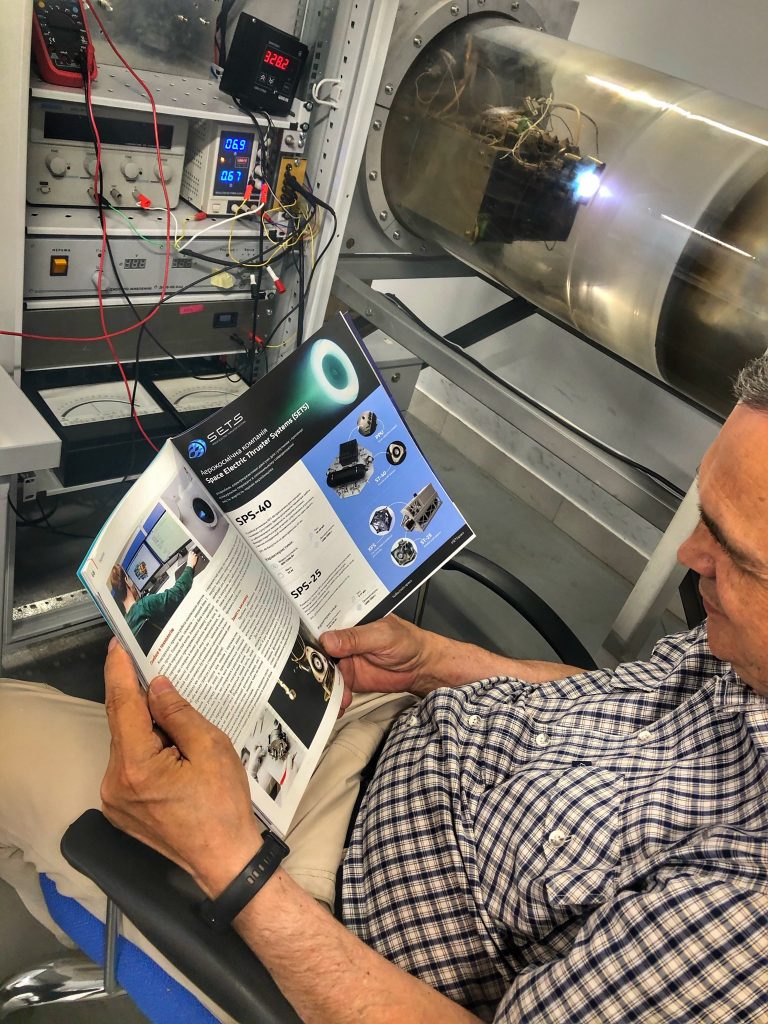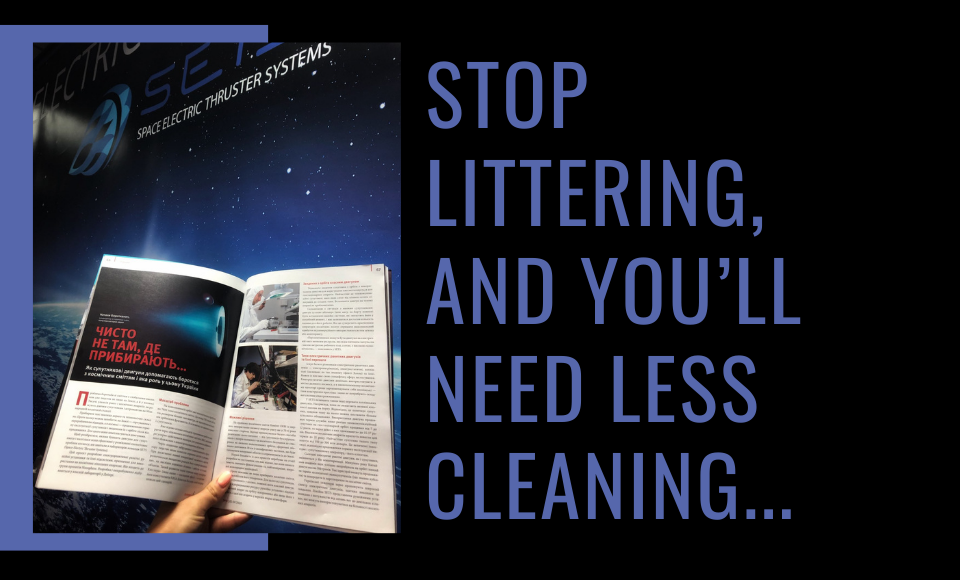Source: The Universe, Space, Tech, #3 (178) 2020
The problem of garbage management is a global challenge for humankind not only on Earth but also in space. Thousands of fragments of rockets and spacecraft threaten satellites and astronauts on the International Space Station (ISS).
Removal of these piles of garbage is expensive and technologically complicated. However, this can be prevented: on Earth – by sorting and recycling waste, and in space – by prolonging the operational life of satellites and removing them from the orbit after completion of the mission. This requires equipping satellites with thrusters.

To find out what thrusters can be used on satellites and how effective they are in solving the ecological problems of space, we visited the laboratory of SETS (Space Electric Thruster Systems) team.
The SETS project develops electric propulsion systems and their subsystems designated for use on spacecraft. This project is a part of the Noosphere group of projects. The development and testing are done in the project’s own laboratory in the city of Dnipro.
The scale of the problem
There are about 7600 tons of space junk orbiting the Earth. They include over 750 thousand objects more than a centimeter across and millions of smaller fragments. Mostly these are remnants of rockets and satellites.
There are already several known cases when an operation of some spacecraft was terminated because of collisions with space debris. The ISS has to regularly perform maneuvers for avoiding dangerous closing in with uncontrolled objects.
Further pollution of the near-Earth space may completely prevent our access to space. At a certain concentration of space debris, a chain reaction of its self-replication can start as a result of collisions and explosions of artificial orbital objects. This potential development of events was named the Kessler syndrome (also known as collisional cascading and ablation cascade) – after NASA consultant Donald Kessler, who described this scenario for the first time.
Possible solutions
The problem of space junk attracted attention of the UN Committee on the Peaceful Uses of Outer Space still in the 1970s. Since then, many ways of solving this problem have been proposed from tug satellites and ground- or space-based lasers to formation of a 30-kilometer-thick belt with tungsten particles that would decelerate junk objects and cause their re-entry into the atmosphere.
Currently, most of these projects are on the stage of development or testing, but it is already known that they will require considerable financing and, very likely, will be developed in international cooperation.
However, as SETS representatives believe, it is important not to just remove the space junk, but also to prevent its formation. For this, all satellites sent to space should have a thruster. After the accomplishment of the mission, the spacecraft can use propulsion to lift itself to a graveyard orbit or to quit its orbit and enter a descent trajectory, after which it will burn down in the atmosphere.
Quitting the orbit on its own thruster
The technology of removal of a satellite from orbit by its own orbital correction thruster is already used for geostationary satellites. Typically, these are telecommunication satellites, the mass of which ranges from several hundred kilograms to several tons. Adding a thruster to such a satellite is not a problem.

It is more complicated with small satellites: the addition of a thruster substantially increases their mass, accompanying onboard systems are required which will fire the thruster when necessary and there has to be sufficient storage of propellant for its operation throughout the mission. All this contradicts with the desire of space service operators to obtain the maximum profit from commercial usage of communication or monitoring systems.
“A perspective solution can be electric thrusters with long service life, high specific impulse and small consumption of propellant, and, therefore, very economical,” – SETS specialists explain.
Types of electric rocket engines and their advantages
There is a wide variety of electric rocket engines – those using electric power for heating the reaction mass, electrostatic ones, Hall-effect engines, and others. Each of them has its sphere of applications. Electrostatic thrusters better suit for deep space applications, while in the near-Earth space Hall-effect thrusters are more feasible – their design is simpler and they do not require a complicated power supply system.
People at SETS also mention other advantages of Hall-effect thrusters. For instance, these thrusters do not require large amounts of propellant on board. Consequently, this makes the satellite lighter and allows installation of more equipment serving the purpose of the mission. Also, using these thrusters prolongs the operational life of the satellite: if earlier a telecommunication satellite in the geostationary orbit operated 7 to 12 years, now some of them “live” as long as 15 to 17 years. Satellite operators strive to extend this time to 21 years. Typically, satellites of this kind cost from 150 to 300 million dollars. This is a large investment, and extension of the operational lifetime is beneficial to both the satellite operator and its customers.
Now, electric thrusters, as well as satellites, tend to miniaturization. Last year the Chinese Academy of Science successfully carried out an in-orbit test of ion thrusters weighing 300 grams. Such devices can prolong mission time of nanosatellites (so-called cubesats) and prevent their turning into space junk after the end of their missions.
Ukrainian engineers now offer a wide range of electric thrusters capable of doing this. The SETS’s product line features propulsion systems of power from hundreds of watts to several kilowatts suitable for operation on the majority of spacecraft.
Deeper into the technology
The design and principle of operation of the Hall-effect thruster are rather simple. Its main components are the anode unit and external hollow cathode. The anode unit consists of a toroidal accelerating channel and a magnetic system creating in it a radial magnetic field. At the base of the channel, the gas injecting anode is mounted, through which the propellant gas is injected, which is just xenon. The walls of the channel can be made of a dielectric material (and this will be a stationary plasma thruster) or of a metal (a thruster with an anode layer).
Application of voltage between the anode and hollow cathode causes an arc discharge that ionizes the propellant gas. Ions from the discharge are accelerated by the longitudinal electric field forming a jet of ions at the exit of the thruster, and this is how the thrust is created. In addition to creation of the arc discharge, the hollow cathode is also used for neutralization of the ion jet. As a result, atoms of the propellant gas become neutral when they leave the thruster.
Apart from the thruster itself, the propulsion system includes a system for storing and feeding the propellant to the anode and hollow cathode, a power supply system that converts the voltage of the onboard power source into the voltages and currents required for operation of the propulsion system, a control and monitoring system that connects the propulsion system with the onboard control system by forming commands to the components of the propulsion system and collecting and providing telemetry feedback on their state and operation.
Instead of a conclusion
The problem of pollution of the near-Earth space is already acute and is going to get worse. Even if we stop all launches of spacecraft, the number of objects of debris will continue to increase because of collisions and explosions of orbital objects.
For postponing the Kessler effect, it is necessary to at least maintain a relatively low generation of more waste. And this requires obliging all manufacturers of satellites to equip them with thrusters, which will enable self-removal of spacecraft from orbits after the end of their missions. The development of a sufficiently simple, cheap, and effective thruster for this purpose is what Ukrainian specialists are actively working on now.





